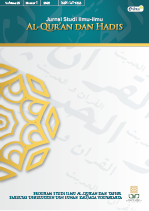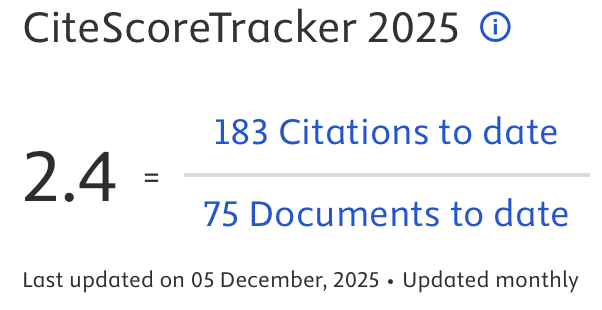Naqd al-Qirāʾāt ʿinda al-Mufassirin: Dirāsat Muqāranat linaqd al-Ṭabari wa al-Ṭūsi liriwāyati Ḥafṣ ʿan ʿĀṣim
DOI:
https://doi.org/10.14421/qh.2022.2301-02Keywords:
Ḥafṣ’ riwaya, al-Tabari, al-Tusi, criticism on qira’atAbstract
This article attempts to highlight the critical position towards Ḥafṣ’ riwāya held by the Sunni exegete Abu Ja’far Muhammad bin Jarir al-Tabari (d. 310/923) and the Shi’ite Abu Ja’far Muhammad ibn al-Hasan al-Tusi (d. 460/1067), both of which had occupied special status in their respective communities. This article focuses on the verses which have variant readings. It compares the ways in which the two exegetes, in their books Jāmi’ al-Bayān fī Ta’wīl Āy al-Qur’ān and al-Tibyān fī Tafsīr al-Qur’ān, present and criticize the variant readings of which Ḥafṣ is infirād (isolated) in that no other imam (the transmitter for the riwāya) would read that part of the Quran the same way as Ḥafṣ did. Al-Ṭabari seems to be more clear and courageous in criticizing Ḥafṣ’ riwāya, compared to al-Ṭūsī. In several cases the former did not consider the riwāya reliable on the basis of the violation of the ijma’ (consensus) of ulama or it being unfamiliar to him (by expressing lā qāri’ qara’ kaẓālik, “no one reads it that way”). On the other hand, al-Ṭūsī contented with exploring linguistic and syntax reasons for upholding the riwaya. In no case would he question the authority of al-qirā’āt al-sab’a (the seven variant readings of the Quran). This might be due to their status as being pre-Ibn-Mujāhid (al-Ṭabarī) and post- (al-Ṭūsī). However, the two exegetes did not base their tafsir on merely one but rather on a number of qirā’at. Thus this paper suggests that Ḥafṣ’ riwāya, particularly among exegetes, was not considered the highest in rank and most prolific as it is now. Abstract viewed: 702 times
|
Abstract viewed: 702 times
|
 PDF downloaded = 759 times
PDF downloaded = 759 times
References
Ibn ‘Asyur, Muhammad al-Thahir. Tafsir al-Tahrir wa al-Tanwir, Tunis: al-Dar al-Tunisiyyah li-nasyr, 1984.
Ibn ‘Asyur, Muhammad al-Fadhil. Al-Tafsir wa Rijaluh. Kairo: Dar al-Salam li Thiba’ah wa Nasyr, 2008.
Ibn Faris, Abu al-Husain Ahmad. Mu’jam Maqayis al-Lughah. Bairut: Dar al-Fikr, 1979.
Aal Ismail, Nabil bin Muhammad Ibrahim. ‘Ilm al-Qira’at: Nasy’atuh, Athwaruh, Atharuh fi al-‘Ulum al-Syar’iyyah. Riyahd: Maktabah al-Taubah, 2000.
Al-Amin, al-Sayyid Muhsin. A’yan al-Syi’ah. Edit. Hasan al-Amin. Bairut: Dar al-Ta’aruf li al-MAthbu’at, 1986.
Ayazi, Muhammad Ali. Al-Mufassirun Hayatuhum wa Manhajuhum. Thahran: Mu’assasah al-Thiba’ah wa al-Nasyr Wazarah al-Tsaqafah wa al-Irsyad.
Ba Zammul, Muhammad Umar Salim. al-Qira’at wa Atharuha fi al-Tafsir wa al-Ahkam. Disertasi. Mekkah: kulliyah al-Da’wah wa Ushul al-Din.
Al-Baghdadi, Abu Bakr Ahmad bin Musa bin ‘Abbas bin Mujahid. Kitab al-Sab’ah fi al-Qiraat. Edit. Syauqi Dhaif. Kairo: Dar al-Ma’arif.
Al-Jarihi, Majdi bin ‘Awadh. Manhaj al-Syi’ah al-Imamiyyah al-Itsna ‘Asyariah fi Tafsir al-Qur’an, al-Imamiyyah al-Mu’tadilun, al-Thabrisi Namudzajan. 2009.
Adang, Camilla. “Abū Muhammad b. Al-Qurtubī versus Abū ’Alī Al-Rundī: An Andalusī Polemic on the Modes of Transmission of the Qur’an.” Journal of Qur’anic Studies 19, no. 3, 2017.
Aziz, Farhat. “Variant Readings, Companion Codices and Establishment of the Canonical Text (An Analysis the Objections of Arthur Jeffery and A.T. Welch).” European Journal of Social Sciences 28, no. 2, 2012.
Burge, Stephen R. “The Demystification of Magic in the Tafsīr Al-Manār: An Analysis of the Exegetical and Homiletic Devices Used in the Discussion ‘Mabḥath Al-Siḥr Wa-Hārūt Wa-Mārūt.’” Religions 12, no. 9, 2021.
Dutton, Yasin. “ An Early Muṣḥaf According to the Reading of Ibn c Āmir .” Journal of Qur’anic Studies 3, no. 1, 2001.
———. “Red Dots, Green Dots, Yellow Dots and Blue: Some Reflections on the Vocalisation of Early Qur’anic Manuscripts – Part I.” Journal of Qur’anic Studies 1, no. 1, April 1999.
Jabri, Abdullah Abd al-Nashir. Lahajat al-‘Arab fi al-Qur’an al-Karim: Dirasah Istiqra’iyyah Tahliliyyah. Bairut: Dar al-Kutub al-‘Ilmiyyah, 2007.
Ja’far, Khudhair. Al-Syaikh al-Thusi Mufassiran. Qum: Markaz al-Nasyr Maktab al-I’lam al-Islami, 1420.
Ja’far, ‘Abd al-Ghafur Mahmud Musthafa. Al-Qur’an wa al-Qira’at wa al-Ahruf al-Sab’ah. Kairo: Dar al-Salam li al-Thiba’ah wa al-Nasyr, 2008.
Nasser, Shady Hekmat. “Revisiting Ibn Mujahid’s Position on the Seven Canonical Readings: Ibn CA¯mir’s Problematic Reading of Kun Fa-Yaku¯na.” Journal of Qur’anic Studies, 2015.
Al-Hamawi, Abu ‘Abdullah Yaqut al-Rumi. Mu’jam al-Udaba’. Bairut: Dar al-Kutub al-‘Ilmiyyah, 1991.
Al-Khathib, ‘Abd al-Lathif. Mu’jam al-Qira’at. Damaskus: Dar Sa’d al-Din li al-Thiba’ah wa al-Nasyr, 2002.
Al-Dani, Abu ‘Amr ‘Utsman bin Sa’id. al-Tahdzib lima Tafarrad Kullu Wahid min al-Qurra’ al-Sab’ah. edit. Hatim Shalih al-Dhamin. Damaskus: Dar Nainawa li al-Dirasat wa al-Nasyr, 2005.
_____, Ma’rifah al-Qurra’ al-Kibar ‘ala al-Thabaqat wa al-A’shar. edit. Tayyar Altikulac. Istanbul: Turkiye Diyanet Wakfi, 1995.
Da’rah al-Ma’arif al-Syi’iyyah. Bairut: Dar al-Ta’aruf li al-Mathbu’at, 1981.
Al-Dimasyqi, Abu al-Khair Mumahmmad bi Muhammad bin Jazari, Ghayah al-Nihayah fi Thabaqat al-Qurra’. Bairut: Dar al-Kutuub al-‘Ilmiyyah, 2006.
_____, al-Nasyr fi al-Qira’at al-‘Asyr. edit. Ali Muhammad al-Dhabba’. Bairut: Dar al-Kutub al-‘Ilmiyyah.
Al-Zaidi, Kashid Yasir. Manhaj al-Syaikh Abi Ja’far al-Thusi fi Tafsir al-Qur’an: Dirasah Lughawiyyah Nahwiyyah balaghiyyah. Baghdad: Bait al-Hikmah, 2004.
Al-Salus, Ali Ahmad. Ma’a al-Itsnai ‘Asyariyyah fi al-Ushul wa al-Furu’: Mausu’ah Syamilah. Riyadh: Dar al-Fadhilah, 2003.
Al-Sabt, Khalid Utsman. Qawa’id al-Tafsir: Jam’an wa Dirasah. Dar Ibn ‘Affan, 1421.
Al-Sakhawi, Abu al-Hasan ‘Alam al-Din Ali bin Muhammad. Jamal al-Qurra’ wa Kamal al-Iqra’. edit. Ali Husain al-Tawwab. Mekkah: Maktabah al-Turath, 1987.
Al-Sa’id, Labib. Difa’ ‘An al-Qiraat al-Mutawatirah fi Muwajah al-Thabari al-Mufassir. Kairo: Dar al-Ma’arif, 1978.
Sisi, Abd al-Baqi Abd al-Rahman bin Suraqah. Qawa’id Naqd al-Qira’at al-Qur’aniyyah: Dirasah Nazhariyyah Tathbiqiyyah. Riyahd: Dar Kunuz Isybiliah, 2009.
Al-Suyuthi, Jalal al-Din Abd al-Rahman bin Abi Bakr. Al-Itqan fi ‘Ulum al-Qur’an. edit. Muhammad Salim Hasyim. Bairut: Dar al-Kutub al-‘Ilmiyyah, 2007
_____, al-Hawi fi al-Fatawa. Bairut: Dar al-Fikr, 2004.
Syahin, Abd al-Shabur. Tarikh al-Qur’an. Kairo: Nahdhah Mashr li al-Thiba’ah, 2002.
Syalabi, Abd al-Fattah Ismail. Al-Ikhtiyar fi al-Qira’at: Mansya’uh wa Masyru’iyatuh. Makalah. Mekkah: Umm al-Qura University, 1996.
Al-Dhabba’, Ali Muhammad. Al-Idha’ah fi Bayan Ushul al-Qira’ah. Kairo: al-Maktabah al-Azhariah li al-Turats, 1999.
Dhamrah, Taufiq Ibrahim. Al-Nukat al-Lathifah fi Qiraah al-imam Abi Hanifah. Amman, 2014.
Al-Thabrisi, al-Fadhl bin al-Hasan. Majma’ al-Bayan fi Tafsir al-Qur’an. Bairut: Dar al-‘Ulum, 2005.
Al-Thabari, Abu Ja’far Muhammad bin Jarir. Jami’ al-Bayan ‘An Ta’wil Ayy al-Qur’an. Edit. Abd Allah bin Abd al-Muhsin al-Turki. Kairo: Hajr li al-Thiba’ah wa al-Nasyr, 2001.
Al-Thusi, Abu Ja’far Muhammad bin al-Hasan. Al-Tibyan fi Tafsir al-Qur’an. Bairut: Dar Ihya’ al-Turats al-Arabi.
Al-‘Assal, Muhammad Ibrahim. Al-Syi’ah al-Itsna’asyariah wa Manhajuhum fi Tafsir al-Qur’an. 1427.
Al-‘Ala’i, Shadiq. I’lam al-Kahalaf bi man Qal bi Tahrif al-Qur’an min A’lam al-Salaf. Qum: Markaz al-Afaq li al-Dirasat al-Islamiyyah, 1425.
Qabah, Abd al-Halim Muhammad al-Hadi. al-Qira’at al-Qur’aniyyah: Tarikhuha, Tsubutuha, Hujjiatuha, Ahkamuha. Bairut: Dar al-Gharab al-Islami, 1999.
Al-Qaisi, Makky bi Abi Thalib. Al-Ibanah fi Ma’ani al-Qiraat. edit Abd al-Fattah Ismail Syalabi. Kairo: Mathba’ah Nahdhah Mishr.
Al-Mar’asyi, Muhammad bin Abi Bakr. Juhd al-Muqil. edit. Salim Qaddui al-Hamd. Amman: Dar ‘Ammar li al-Nasyr wa al-Tauzi’, 2008.
Al-Muzaini, Abd al-Aziz bin Sulaiman. Mabahits fi ‘Ilm al-Qiraat. Riyadh: Dar Kunuz Isybiliyyah, 2011.
Ma’rifah, Muhammad Hadi. Al-Tamhid fi Ulum al-Qur’an. Qum: Mu’assasah al-Nasyr al-Islami, 1411.
Maharisy, Zaid Ali Mahdi. Manhaj al-Imam al-Thabari fi al-Qiraat wa Dhawabith Ikhtiyariha fi Tafsirih. Disertasi. Imam Muhammad bi Sa’ud Uiniversity. 1419.
Noldeke, Theodor. Tarikh al-Qur’an. Bairut: Auflage, 2004.
Al-Harari, Muhamad Arif Utsman, al-Qiraat allati Ankaraha Ibn Jarir al-Thabari fi Tafsirih wa al-Rad ‘alaih. Tesis MA. Madinah: al-Jami’ah al-Islamiyyah, 1986.
Walad Abbah, Muhammad al-Mukhtar. Tarikh al-Qiraat fi al-Masyriq wa al-Maghrib. ISESCO, 2001.
Michel W. Albin, “Printing of the Qur’an”, Encyclopedia of The Qur’an, edit. Jane Dammen McAuliffe, Leiden: Brill, 2004.
Mustofa, Pembakuan Qira’at ‘Ashim Riwayat Hafs dalam Sejarah dan Jejaknya di Indonesia, dalam Suhuf: Jurnal Kajian al-Qur’an dan Kebudayaan, Jakarta: Lajnah Pentashihan Mushaf Al-Qur’an Badan Litbang dan Diklat Depag RI, vol. 4, no. 2, 2011.
Rabb, Intisar A. “Non-Canonical Readings of the Qur’an: Recognition and Authenticity Persist? (The Himsī Reading).” Journal of Qur’anic Studies 8, no. 2, October, 2006
Shah, Mustafa. “Variant Readings of the Qur’an: A Critical Study of Their Historical and Linguistic Origins. By Ahmad CAlī Al-Imām. Pp. 191. Herndon, Virginia: The International Institute of Islamic Thought, 1998.” Journal of Qur’anic Studies 4, no. 1, 2002.
Downloads
Published
How to Cite
Issue
Section
License
Publishing your paper with Jurnal Studi Ilmu-ilmu al-Qur'an dan Hadis means that the author or authors retain the copyright in the paper. Jurnal Studi Ilmu-ilmu al-Qur'an dan Hadis uses license CC-BY-NC-ND or an equivalent license as the optimal license for the publication, distribution, use, and reuse of scholarly works. This license permits anyone to copy and redistribute the material in any medium or format and must give appropriate credit, provide a link to the license, and indicate if changes were made. If you remix, translate, transform or build upon the material you may use it for private use only and not for distribution. Jurnal Studi Ilmu-ilmu al-Qur'an dan Hadis granted an exclusive non-commercial reuse license by the author(s), but the author(s) are able to put the paper onto a website, distribute it to colleagues, give it to students, use it in your thesis, etc, so long as the use is not directed at a commercial advantage or toward private monetary gain. The author(s) can reuse the figures and tables and other information contained in their paper published by Jurnal Studi Ilmu-ilmu al-Qur'an dan Hadis in future papers or work without having to ask anyone for permission, provided that the figures, tables, or other information that is included in the new paper or work properly references the published paper as the source of the figures, tables or other information, and the new paper or work is not direct at a private monetary gain or commercial advantage.
Jurnal Studi Ilmu-ilmu al-Qur'an dan Hadis journal Open Acces articles are distrubuted under the Creative Commons Attribution-NonCommercial-NoDerivatives 4.0 International (CC BY-NC-ND 4.0). Article can be read, copy and redistribute the material ini any medium or format under the following conditions:
Attribution — You must give appropriate credit, provide a link to the license, and indicate if changes were made. You may do so in any reasonable manner, but not in any way that suggests the licensor endorses you or your use.
NonCommercial — You may not use the material for commercial purposes.
NoDerivatives — If you remix, transform, or build upon the material, you may not distribute the modified material.










